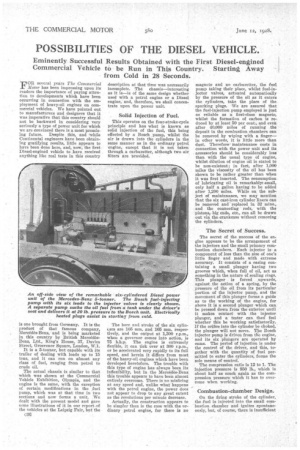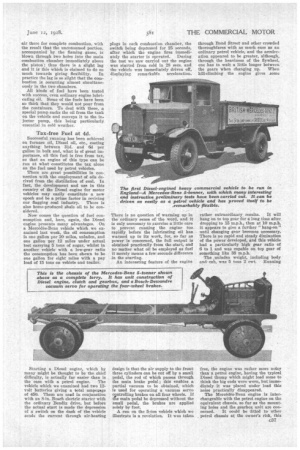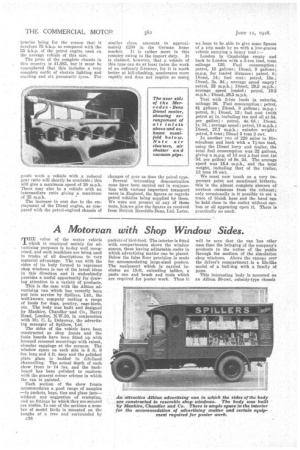POSSIBILITIES OF THE DIESEL VEHICLE.
Page 58

Page 59

Page 60

If you've noticed an error in this article please click here to report it so we can fix it.
Eminently Successful Results Obtained with the First Diesel-engined Commercial Vehicle to be Run in This Country. Starting Away from Cold in 28 Seconds.
FO".several years The Commercial Motor has been impressing upon its readers the importance of paying attention to developments which have been occurring in connection with the employment of heavy-oil engines on commercial vehicles. We have pointed out to manufacturers and designers that it was imperative that this country should not be backward in considering very seriously a type of power unit for which we are convinced there is a most promising future. Despite this, and -while Continental engineers have been obtaining gratifying results, little appears to have been done here, and, now, the first Diesel-engined vehicle to have received anything like real tests in this country is one brought from Germany. It is the product of that famous company, Mercedes-Bens, and is being marketed in this country by British MercedesBenz, Ltd., King's House, 37, Davies Street, Grosvenor Square, London, W.1.
It is a 5-tanner, but capable with its trailer of dealing with loads up to 15 tons, and it can run on almost any class of fuel, ranging from petrol to crude oil.
The actual chassis is similar to that which was shown at the Commercial Vehicle Exhibition, Olympia, and the engine is the same, -with the exception of certain modifications in the fuel pump, which was at that time in two sections and now forms a unit. We dealt with the present model and gave some illustrations of it in our report. of the vehicles at the Leipzig Fair, but the
e3G description at that time was necessarily incomplete. The chassis—interesting as it is—is of the same design whether used with a petrol engine or a Diesel engine, and, therefore, we shall concentrate upon the power unit.
• Solid Injection of Fuel.
This operates on the four-stroke-cycle principle and has what is known as solid injection of the fuel, this being effected by a Bosch pump, whilst the air is drawn into the cylinders in the same manner as in the ordinary petrol engine, except that it is not taken through a carburetter, although two air filters are Provided.
The bore and stroke of the six cylinLars are 105 mm. and 165 mm. respectively, and the output at 1,300 r.p.m., when a governor comes into action, is 75 blip. The engine is extremely flexible, it can tick over at 300 r.p.m., or be accelerated very rapidly to its full speed, and herein it differs from most of the heavy-oil engines which have been developed heretofore. The trouble with this type of engine has always been its inflexibility, but in the Merceas-Benz this trouble appears to have been almost entirely overcome. There is no misfiring at any speed and, unlike what happens with the petrol engine, the power does not appear to drop to any great extent as the revolutions per minute decrease.
Actually, the construction appears to be simpler than is the case with the 'ordinary petrol engine, for there is no
magneto and no carburetter, the fuel pump taking their place, whilst fuel-injector valves, actuated automatically by the pressure of the oil as it enters the cylinders, take the place of the sparking plugs. We are assured that the fuel-injection pump employed is just as reliable as a first-class magneto, whilst the formation of carbon is reduced by at least 50 per cent., and even after 40,000 miles of running the deposit in the combustion chambers can be removed by wiping with a finger— in other words, it is little more than dust. Therefore maintenance costs in connection with the power unit and its accessories should be considerably less than with the usual type of engine, whilst dilution of engine oil is stated to be non-existent; in fact, after 1,000 miles the viscosity of the oil has been shown to be rather greater than when it was first inserted. The consumption of lubricating oil is remarkably
only half a gallon having to be added after 1,200 miles. While on the subject of maintenance, we may mention that the six cast-iron cylinder liners can be removed and replaced in 32 mine., and the connecting rods, with the pistons, big ends, etc., can all be drawn out via the crankcase without removing the cylinders.
The Secret of Success.
The secret of the success of the engine appears to be the arrangement of the injectors and the small primary combustion chambers. Each injector is a component of less than the size of one's little finger and made with extreme accuracy. It consists of a casing containing a small plunger having two grooves which, when full of oil, act as something in the nature of sealing rings. This plunger is forced .upwards, against the action of a spring, by the pressure of the oil from its particular portion of the injector pump, and the movement of this plunger forms a guide as to the working of the engine, for above it is a second plunger which can be pressed down from the exterior until It makes contact with the injector plunger, and a tester can thed feel whether this be working satisfactorily. If the orifice into the Cylinder be choked, the plunger will not move. The Bosch injector pump is driven from the engine, and its six plungers are operated by cams. The period of injection is under the control of the driver, and this, together with the quantity of fuel permitted to eater the cylinders, forms the sole means of control.
The compression ratio is 12 to 1. The injection pressure is 950 lb., which is about half as much again as the compression pressure which it has to overcome when working.
Combustion-chamber Design.
On the firing stroke of the cylinder, the fuel is injected into the small combustion chamber and ignites spontaneously, but, of course, there is insufficient air there for complete combustion, with the result that the unconsmned portion, accompanied by the flaming gases, is blown through two holes into the main combustion chamber immediately above the piston; thus there is a slight lag and it is this which is claimed to do so much towards giving flexibility. In practice the lag is so slight that the com bustion is occurring almost simultaneously in the two chambers.
All kinds of fuel have been tested with success, even ordinary engine lubricating oil. Some of the fuels have been so thick that they would not pour from the containers. To deal with these, a special pump sucks the oil from the tank on the vehicle and conveys it to the injector pump, this being particularly essential in cold weather.
Tax-free Fuel at 4d.
Successful running has been achieved on furnace oil, Diesel oil, etc., costing anything between 31d. and 8d per gallon in bulk and, what is of great ifilportance, all this fuel is free from tax, so that an engine of this type can be run at what constitutes the tax alone on the fuel used by petrol vehicles.
There are great possibilities in connection with the employment of oils derived from the distillation of coal. In fact, the development and we in this country of the Diesel engine for motor vehicles may easily constitute a new epoch and be a prime factor in reviving
our flagging coal industry. There is also home-produced shale oil to be eonsidered.
Now comes the question of fuel consumption and, here, again, the Diesel engine presents many advantages. On a Mercedes-Benz vehicle which we examined last week, the oil con.sumption is one gallon per 20 miles, unladen, and one gallon per 12 miles under actual test carrying 5 tons of sugar, whilst in another vehicle with a low-gear ratio the consumption has been shown to be one gallon for eight miles with a pay load of 15 tons on vehicle and trailer.
Starting a Diesel engine, which by many might be thought to be the chief difficulty, is actually far easier than is the case with a petrol engine. The vehicle which we examined had two 12volt batteries giving a total ampelage of 450. These are used in conjunction with an 8-in. Bosch electric starter with the ordinary Bendix drive, but before the actual start is made the depression of a switch on the dash of the vehicle sends the current through air-heating plugs in each combustion chamber, the switch being depressed for 25 seconds, after which the engine fires immedi ately the starter is operated. During the test we saw carried out the engine was started from cold in 28 geCt9. and the vehicle was immediately driven off, displaying remarkable acceleration.
There is no question of warming up in the ordinary sense of the word, and it is only necessary to exercise a little care to prevent running the engine too rapidly before the lubricating oil has warmed up to its work, for, so far as power is concerned, the full output is obtained practically from the start, and DO matter what oil be employed as fuel it merely means a few seconds difference in the starting.
An interesting feature of the engine
design is that the air supply to the front three cylinders can be cut off by a small pedal, the rod of which passes through the main brake pedal; this enables a partial vacuum to be obtained, which is used for operating a vacuum servo controlling brakes on all four wheels. If the main pedal be depressed without the small pedal, the brakes are applied solely by foot.
A run on the 5-ton vehicle which we illustrate is a revelation. It was taken through Bond Street and other crowded thoroughfares with as much ease as an ordinary petrol vehicle, and the acceleration appeared to be greater, although, through the heaviness of the flywheel, one has to wait a little longer between the gears when changing up. Wheu hill-climbing the engine gives some
rather extraordinary results. It will
hang -on to top gear for a long time after dropping to 15 m.p.h., then at 10 m.p.h. it appears to give a further "bang-on" until changing gear becomes necessary. There is no rapid and steady diminution of the power developed, and this vehicle had a particularly high gear ratio of 6 to 1 and was capable on top gear of something like 38 m.p.h.
The unladen weight, including body and cab, was 5 tons 2 cwt. Running free, the engine was rather more noisy than a petrol engine, having the typical Diesel thump which might lead some to think the big ends were worn, but immediately it was placed under load this noise practically disappeared.
The Mercedes-Benz engine is interchangeable with the petrol engine on the equivalent chassis, so far as the mounting holes and the gearbox unit are con
cerned. It could be fitted to other . petrol chassis at the owner's risk, this
proviso being for the reason that it develops 75 b.h.p. as compared with the 55b.h.p. of the petrol engine used on the average vehicle of this Si7.e.
The price of the complete chassis in this country is £1,685, but it must be remembered that this includes a very complete outfit of electric lighting andstarting and six pneumatic tyres. For
goods work a vehicle with a reduced gear ratio will shortly be available ; this will give a maximum speed of 20 m.p.h. There may also be a vehicle with an intermediate ratio giving a maximum of 25 m.p.h.
The increase in cost due to the employment of the Diesel engine, as compared with the petrol-engined chassis of similar doss, amounts to approximately £250 in the German home
market. It is rather more in this country owing to the import duty. It is claimed, however, that a vehicle of this type can do at least twice the work of an ordinary 5-tonner, for it is much better at hill-climbing, accelerates more rapidly and does not require so many.
changes of gear as does the petrol type.
Several interesting demonstration runs have been carried out in conjunction with various important transport users in England, the figures as regards petrol vehicles being supplied by them. We were not present at any of those tests, but,we give the figures as received from British Mercedes-Benz, Ltd. Later, we hope to be able to give some figures of a trip made by us with a low-gearea vehicle carrying a heavy load • London to Cambridge empty and back to London with a 5-ton load, total mileage 126. Fuel consumption: petrol, 15 gallons ; Diesel, 9 gallons ; m.p.g. for loaded distance : petrol, 8; Diesel, 14; fuel cost: petrol, 15s.; Diesel, 3s. 9d.; average speed empty! petrol, 22 m.p.h.; Diesel, 29.5 m.p.h.; average speed loaded : petrol, 19.2 m.p.h,; Diesel, 26,5 m.p.h.
Test with 5-ton loads in suburbs, mileage 36. Fuel consumption : petrol, 4i gallons ; Diesel, 3 gallons ; m.p.g.: petrol, 8; Diesel, 12; fuel cost (with petrol at La. including tax and oil at 5d. per gallon) : petrol, 4s, 6d.; Diesel, 1s. 3&; average speed : petrol, 18 m.p.h. ; Diesel, 27.7 m.p.h.; unladen weight: petrol, 5 tons; Diesel 5 tons 2 cwt.
In another run of 220 miles to Birmingham and back with a 7i-ton load, using the Diesel lorry and trailer, the total fuel consumption was 22 gallons, giving a m.p.g. of 10 and a fuel cost (at 5d. per gallon) of Os. 2d. The average speed was 18.4 m.p.h, and the total weight, including that of the trailer, 13 tons 16 cwt.
We must now touch on a very important point not mentioned hitherto, this is the almost complete absence of noxious emissions from the exhaust; only occasionally is it possible to see a trace of bluish haze and the band can be held close to the outlet without carbon or oil appearing upon it. There is practically no smell.












































































































